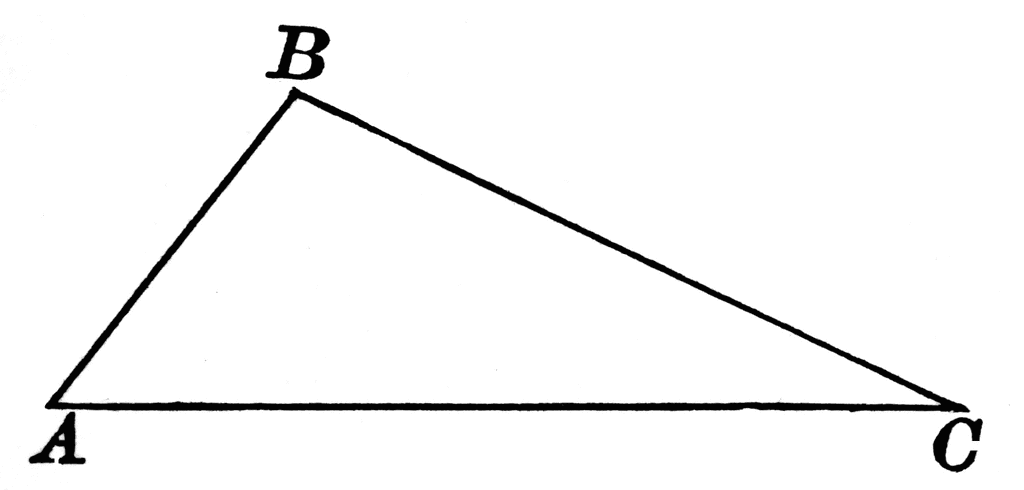All HSPT Math Resources
Example Questions
Example Question #1 : Acute / Obtuse Triangles
Points A, B, and C are collinear (they lie along the same line). The measure of angle CAD is 


Find the measure of 
The measure of 








Because the measures of the three angles in a triangle must add up to 





Example Question #1 : Triangles
Points A and B lie on a circle centered at Z, where central angle <AZB measures 140°. What is the measure of angle <ZAB?
20°
25°
15°
30°
Cannot be determined from the given information
20°
Because line segments ZA and ZB are radii of the circle, they must have the same length. That makes triangle ABZ an isosceles triangle, with <ZAB and <ZBA having the same measure. Because the three angles of a triangle must sum to 180°, you can express this in the equation:
140 + 2x = 180 --> 2x = 40 --> x = 20
Example Question #1 : Triangles
Triangle FGH has equal lengths for FG and GH; what is the measure of ∠F, if ∠G measures 40 degrees?
None of the other answers
40 degrees
70 degrees
100 degrees
140 degrees
70 degrees
It's good to draw a diagram for this; we know that it's an isosceles triangle; remember that the angles of a triangle total 180 degrees.
Angle G for this triangle is the one angle that doesn't correspond to an equal side of the isosceles triangle (opposite side to the angle), so that means ∠F = ∠H, and that ∠F + ∠H + 40 = 180,
By substitution we find that ∠F * 2 = 140 and angle F = 70 degrees.
Example Question #1 : How To Find An Angle In An Acute / Obtuse Isosceles Triangle
The vertex angle of an isosceles triangle is 
An isosceles triangle has two congruent base angles and one vertex angle. Each triangle contains 



Example Question #2 : Acute / Obtuse Isosceles Triangles
In an isosceles triangle the base angle is five less than twice the vertex angle. What is the sum of the vertex angle and the base angle?
Every triangle has 180 degrees. An isosceles triangle has one vertex angle and two congruent base angles.
Let 
and 
So the equation to solve becomes
or
Thus the vertex angle is 38 and the base angle is 71 and their sum is 109.
Example Question #1 : How To Find An Angle In An Acute / Obtuse Isosceles Triangle
Sides 



This triangle has an angle of 




Example Question #2021 : Hspt Mathematics

In triangle ABC, Angle A = x degrees, Angle B = 2x degrees, and Angle C = 3x+30 degrees. How many degrees is Angle B?
105°
45°
25°
50°
30°
50°
Because the interior angles of a triangle add up to 180°, we can create an equation using the variables given in the problem: x+2x+(3x+30)=180. This simplifies to 6X+30=180. When we subtract 30 from both sides, we get 6x=150. Then, when we divide both sides by 6, we get x=25. Because Angle B=2x degrees, we multiply 25 times 2. Thus, Angle B is equal to 50°. If you got an answer of 25, you may have forgotten to multiply by 2. If you got 105, you may have found Angle C instead of Angle B.
Example Question #221 : Plane Geometry
An isosceles triangle has a base angle that is six more than three times the vertex angle. What is the base angle?
Every triangle has 180 degrees. An isosceles triangle has one vertex angle and two congruent base angles.
Let 

Then the equation to solve becomes
or

Solving for 
Example Question #221 : Geometry
The base angle of an isosceles triangle is thirteen more than three times the vertex angle. What is the difference between the vertex angle and the base angle?
Every triangle has 
Let 

The equation to solve becomes 
Now we can solve for the vertex angle.
The difference between the vertex angle and the base angle is 
Example Question #1 : Triangles
What is the sine of the angle between the base and the hypotenuse of a right triangle with a base of 4 and a height of 3?
By rule, this is a 3-4-5 right triangle. Sine = (the opposite leg)/(the hypotenuse). This gives us 3/5.
Certified Tutor
Certified Tutor
All HSPT Math Resources














































